Violet Falls Cardigan |
|
 |
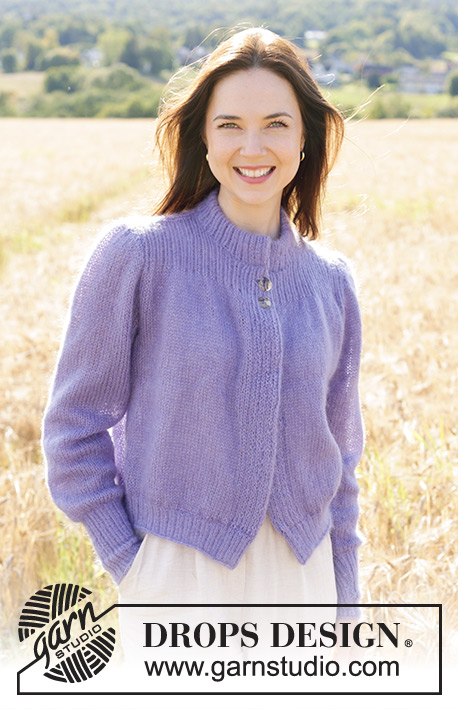 |
Knitted jacket in 2 strands DROPS Kid-Silk. Piece is knitted bottom up with sewn-in puffed sleeves and double neck edge. Size: S - XXXL
DROPS 250-30 |
|
|
---------------------------------------------------------- EXPLANATION FOR THE PATTERN: ---------------------------------------------------------- GARTER STITCH (when working back and forth): Knit on all rows, i.e. knit from right side and knit from wrong side. 1 ridge vertically = knit 2 rows. INCREASE TIP (mid under sleeve): Increase 2 stitches on round by increasing on each side of marker thread as follows: Work until 1 stitch remain before marker thread, make 1 yarn over, knit 2 (marker thread is in the middle of these 2 stitches), make 1 yarn over (= 2 stitches increased). On next round knit yarn over twisted to avoid holes. Then work the new stitches in stocking stitch. BUTTONHOLES: Decrease for buttonholes on right band, decrease from right side (band = 16 stitches and to be folded double in towards wrong side). Decrease for 2 buttonholes on the same row as the band is folded double in towards wrong side and buttons are buttoned through both layers. ROW 1 (= right side): Work the first 3 stitches as before, make 1 yarn over, knit 2 together, work the next 6 stitches as before, knit 2 together, make 1 yarn over, work the rest of row as before. ROW 2 (= wrong side): Work as before, knit yarn overs to make holes. Decrease 2 buttonholes when piece measures: S: 36 and 40 cm. M: 38 and 42 cm. L: 39 and 43 cm. XL: 40 and 44 cm. XXL: 41 and 45 cm. XXXL: 41 and 46 cm. ---------------------------------------------------------- START THE PIECE HERE: ---------------------------------------------------------- JACKET - SHORT OVERVIEW OF THE PIECE: In this pattern needles of different length have been used, begin with fitting length for number of stitches and switch as needed. Work piece back and forth on needle, from the bottom and up to armholes. Divide the piece for front piece and back piece and finish each part separately. Work sleeves bottom up, and work in the round on needle until armhole, then work sleeve cap back and forth on row. Sew parts together. Finish by picking up stitches around the neck and working a double neck edge. BODY: Cast on 232-247-262-283-307-328 stitches on circular needle size 4.5 mm with 2 strands DROPS Kid-Silk. Switch to circular needle size 3 mm and purl 1 row from wrong side. Work next row as follows from right side: 1 stitch in GARTER STITCH - read explanation above, work rib (= knit 2/purl 1), until 3 stitches remain, knit 2 and 1 stitch in garter stitch. Continue rib back and forth like this until piece measures 4-4-5-5-6-6 cm. Switch to circular needle size 4.5 mm and work next row from right side as follows: 1 stitch in garter stitch, work rib as before over the next 15 stitches (= band that later is folded in towards wrong side), work in stocking stitch until 16 stitches remain and decrease at the same time 20-19-22-23-27-28 stitches evenly over these stitches in stocking stitch, work rib as before over the next 15 stitches, finish with 1 stitch in garter stitch (= band that later is folded in towards wrong side) = 212-228-240-260-280-300 stitches. Insert 1 marker thread 61-65-68-73-78-83 stitches in from each side (= 90-98-104-114-124-134 stitches between marker threads on back piece). Move the marker threads upwards when working; they should be used for dividing for front piece and back piece. Then work in stocking stitch with 1 stitch in garter stitch and 15 stitches rib at the edge in each side as before. REMEMBER THE KNITTING TENSION! When piece measures 30-31-32-33-34-35 cm and next row is worked from wrong side, divide piece for front pieces and back piece as explained below. DIVIDING FOR FRONT PIECES AND BACK PIECE: Work next row as follows from wrong side: Work the first 58-62-64-69-73-78 stitches as before (= front piece including band), cast off the next 6-6-8-8-10-10 stitches for armhole, work 84-92-96-106-114-124 stitches in stocking stitch (= back piece), cast off the next 6-6-8-8-10-10 stitches for armhole, work the last 58-62-64-69-73-78 stitches as before (= front piece including band). Finish front pieces and back piece separately. RIGHT FRONT PIECE: = 58-62-64-69-73-78 stitches. Begin from right side, work in stocking stitch back and forth with 16 band stitches as before, and cast off stitches for armhole in the side on every other row as follows: Cast off 2 stitches 2-2-3-4-5-6 times and 1 stitch 2-3-3-3-5-5 times = 52-55-55-58-58-61 stitches on needle. Remember BUTTONHOLES - read explanation above. Continue until piece measures 38-40-41-42-42-42 cm and next row is worked from right side. Switch to circular needle size 3 mm and work next row from right side as follows: 1 stitch in garter stitch, work rib (= knit 2/purl 1), until 3 stitches remain, knit 2 and 1 stitch in garter stitch. Continue rib back and forth like this. When piece measures 42-44-45-46-47-48 cm, cast off the outermost 22-22-22-24-24-24 stitches for neck. Continue rib as before and cast off stitches for neck on every other row as follows: Cast off 2 stitches 4-4-4-4-4-4 times and 1 stitch 3-3-3-4-4-4 times = 19-22-22-22-22-25 stitches remain for shoulder. Work rib with 1 stitch in garter stitch in each side until piece measures 50-52-54-56-58-60 cm and next row is worked from wrong side. Knit 1 row from wrong side, switch to circular needle size 4.5 mm and cast off. LEFT FRONT PIECE: = 58-62-64-69-73-78 stitches. Begin from right side, work in stocking stitch back and forth with 16 band stitches as before, and cast off stitches for armhole in the side on every other row as follows: Cast off 2 stitches 2-2-3-4-5-6 times and 1 stitch 2-3-3-3-5-5 times = 52-55-55-58-58-61 stitches on needle. Continue until piece measures 38-40-41-42-42-42 cm and next row is worked from right side. Switch to circular needle size 3 mm and work next row from right side as follows: 1 stitch in garter stitch, work rib (= knit 2/purl 1), until 3 stitches remain, knit 2 and 1 stitch in garter stitch. Continue rib back and forth like this. When piece measures 42-44-45-46-47-48 cm, cast off the outermost 22-22-22-24-24-24 stitches for neck. Continue rib as before and cast off stitches for neck on every other row as follows: Cast off 2 stitches 4-4-4-4-4-4 times and 1 stitch 3-3-3-4-4-4 times = 19-22-22-22-22-25 stitches remain for shoulder. Work rib with 1 stitch in garter stitch in each side until piece measures 50-52-54-56-58-60 cm and next row is worked from wrong side. Knit 1 row from wrong side, switch to circular needle size 4.5 mm and cast off. BACK PIECE: = 84-92-96-106-114-124 stitches. Begin from right side, work in stocking stitch back and forth and cast off stitches for armholes in each side on every other row as follows: Cast off 2 stitches 2-2-3-4-5-6 times and 1 stitch 3-4-4-4-6-6 times (cast off 1 stitch more in each side on back piece than on front piece to make the rib fit) = 70-76-76-82-82-88 stitches on needle. Work in stocking stitch with 1 stitch in garter stitch in each side until piece measures 38-40-41-42-42-42 cm and next row is worked from wrong side. Switch to circular needle size 3 mm and work next row from right side as follows: 1 stitch in garter stitch, work rib (= knit 2/purl 1), until 3 stitches remain, knit 2 and 1 stitch in garter stitch. Continue rib back and forth like this. When piece measures 48-50-52-54-56-58 cm, cast off the middle 30-30-30-36-36-36 stitches for neck, and finish each shoulder separately. Continue rib as before and cast off 1 stitch for neck on next row from the neck = 19-22-22-22-22-25 stitches remain for shoulder. Work rib with 1 stitch in garter stitch in each side until piece measures 50-52-54-56-58-60 cm and next row is worked from wrong side. Knit 1 row from wrong side, switch to circular needle size 4.5 mm and cast off. SLEEVES: Work sleeve in the round. Cast on 54-54-60-60-66-75 stitches on double pointed needles size 4.5 mm with 2 strands. Switch to double pointed needles size 3 mm and work rib = knit 2/purl 1 for 12-12-12-14-14-14 cm. Insert 1 marker thread at the beginning of round (= mid under sleeve), move the marker thread upwards when working - use the marker thread for increase mid under sleeve. Switch to double pointed needles size 4.5 mm and work in stocking stitch in the round - AT THE SAME TIME on first round increase 4-4-4-4-6-5 stitches evenly = 58-58-64-66-72-80 stitches. When piece measures 16-16-16-18-18-18 cm, increase stitches mid under sleeve – read INCREASE TIP and increase as follows: Increase 2 stitches every 2½-2-2-1½-1½-1½ cm 12-14-15-16-16-14 times in total = 82-86-94-98-104-108 stitches. Work in stocking stitch until piece measures 46-45-45-44-43-41 cm. Now cast off stitches mid under sleeve and continue sleeve cap as explained below. SLEEVE CAP: Begin 3-3-4-4-5-5 stitches before marker thread, cast off 6-6-8-8-10-10 stitches for armhole, and work in stocking stitch the entire round = 76-80-86-90-94-98 stitches on needle. Then finish the piece back and forth on needle while AT THE SAME TIME casting off for sleeve cap in each side, cast off on every other row as follows: Cast off 2 stitches 6-8-7-6-6-7 times, then cast off 1 stitch 8-6-9-11-13-13 times = 36-36-40-44-44-44 stitches. On next row from right side knit all stitches together 2 by 2 = 18-18-20-22-22-22 stitches remain. Cast off the remaining stitches. Sleeve measures approx. 58-57-58-58-59-58 cm from cast-on edge. ASSEMBLY: Sew the shoulder seams. Sew sleeve to armhole - adjust so that any extra fabric on sleeve cap is collected mid on top of sleeve so that the sleeve fits in the armhole. Fold bands double in towards wrong side and fasten - make sure that to avoid a tight seam and make sure that buttonholes on right band is on top of each other through both layers. NECK EDGE: Use circular needle size 3 mm and 2 strands. Begin from right side mid front and pick up approx. 96-96-99-111-114-117 stitches around the neck (pick up stitches through both layers over bands), number of stitches must be divisible by 3. Work first row as follows from wrong side: 1 stitch in garter stitch, knit 1, work rib (= purl 2/knit 1), until 1 stitch remains, 1 stitch in garter stitch. Continue rib back and forth like this for 9-9-9-11-11-11 cm. Switch to circular needles size 4.5 mm, and loosely cast off. Fold the rib down on the inside of garment and fasten. Sew opening towards mid front together on neck with neat little stitches. |
|
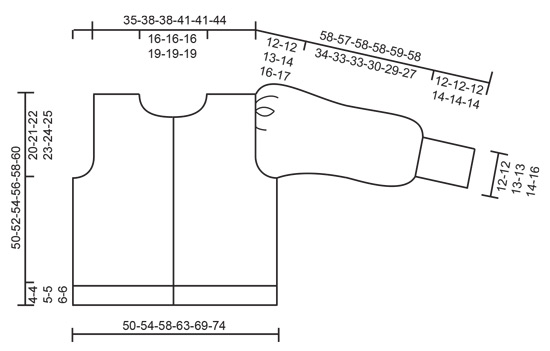
|
|
|
Have you made this or any other of our designs? Tag your pictures in social media with #dropsdesign so we can see them! Do you need help with this pattern?You'll find tutorial videos, a Comments/Questions area and more by visiting the pattern on garnstudio.com. © 1982-2024 DROPS Design A/S. We reserve all rights. This document, including all its sub-sections, has copyrights. Read more about what you can do with our patterns at the bottom of each pattern on our site. |
|








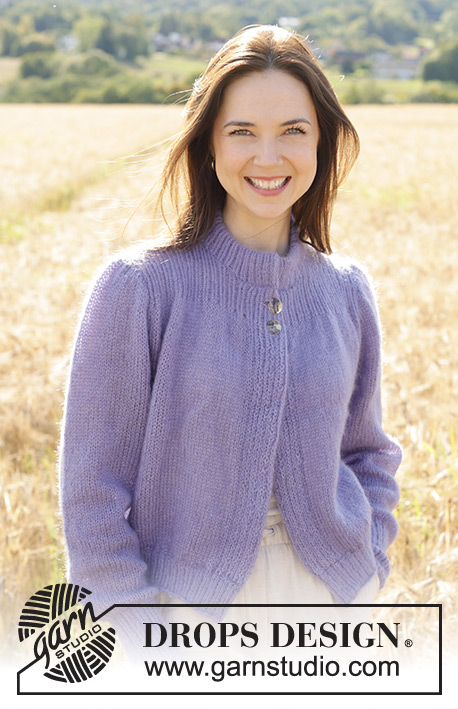


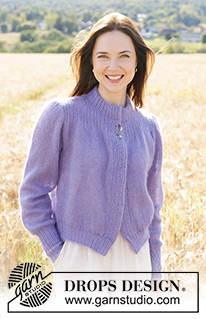

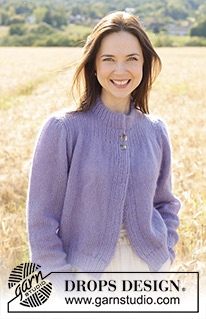
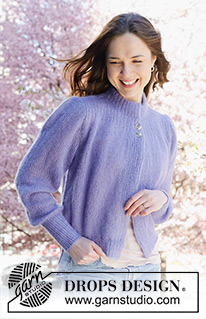





















































Comments / Questions (7)
En Provance
20.01.2024 - 23:40Lady Rose
20.01.2024 - 22:15Madame Tussaud
18.01.2024 - 23:48Quiet Cloister
18.01.2024 - 19:12A vintage vacation
18.01.2024 - 16:51Midsommardröm
18.01.2024 - 16:35Syren
18.01.2024 - 15:41